The official death toll of the devastating floods in Bihar stands at around 514 in 19 out of 38 districts. The real figures are far more. Patna Jesuit Social Action initiative is working with some of the most affected areas in North Bihar. An update:
West Champaran district bordering Nepal has been hit badly. Continuous torrential rains in Nepal and India, and water released from the swelling Valmiki Nagar barrage along the Indo-Nepal border, made rivers and canals in the catchment areas overflow.
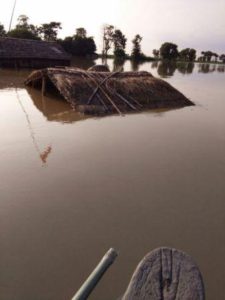
According to media reports, 6 lakh cusecs of water was released from the barrage without prior alarm or warning (TV-News 24), thus which gives the calamity the nature of being man-made. It was tragic that while people were fast asleep on 12 August, water engulfed them, gushing from different routes, with the water level rising to 11 feet.
Suddenly most bridges were destroyed; huge trees uprooted and many huts and ordinary houses were washed away. Many families lost all their belongings, including utensils and cattle. The broken bridges cut off people from the surroundings. The flood waters raged around for almost 4-5 days.
This year the Tharuhat belt from Valmiki Nagar to Mainatad are affected which according to the people of this area is for the first time in 31 years (since 1986).
Though the official estimate puts the death toll as nine in Gaunaha block, people have come across more dead bodies (About 30 at the last count). The situation of some villages of Ramnagar, especially the ‘Don’ area in the Tharu tribe heartland known as Tharuhat is really bad.
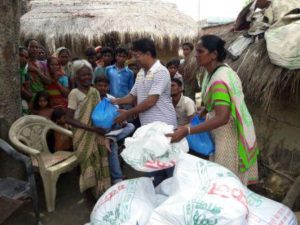
The Jesuits, (Society of Jesus) who have schools and social action centres in Ratanpurwa and Gaunaha, responded to the crisis at the earliest possible moment. Both the school campuses were flooded with water and both the places had over 60 children on campus. The Jesuits in Ratanpurwa sent their tractor to villages to help people transport their belongings to safer ground. In Gaunaha, the Jesuit team began to move out to the reachable villages. In both the places transport and communication were not possible because of broken bridges and non-functional cell phone towers.
The Jesuits began relief operations with a preliminary assessment and helped with whatever was available in the campuses, and then began to procure things and distribute them to the needy. Gradually people tried to put things together.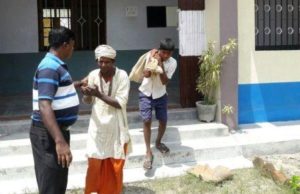
People began to put up bamboo bridges to cross over. The Jesuits began surveying the affected villages with the help of their staff, some of whom had lost their homes.
As of now the water has receded from most of the places. But the people have not been able to come out of the trauma. There are instances where people have found dead bodies in sugar cane fields. On the way to Gaunaha, one can see people lined up in different areas sitting on the roadside, hoping to receive some relief materials. In the entire area, livelihoods are a big concern, as the sugar cane fields are in water and most people have lost their cattle.
——
As and when possible the Jesuits kept reaching out with food provisions. In an immediate response, the Jesuits had reached out to 480 families with items that included beaten rice, jaggery, sugar, etc. After this, in the second time of distribution in Gaunaha and Ramnagar blocks, kits containing 16 items (including rice, dal, utensils, candles, match boxes, etc.) were distributed to people.
In Gaunaha block alone, the Champaran Jesuits have reached out to over 751 families so far. Up to now in Ramnagar block, the first round of distribution is already done in 6 affected villages including the ones in the ‘don’ area.
On 02 September, a team led by Fr. K.C Philip went by tractor and bike and stayed overnight as they were caught up in water and rain. As of now a total of 180 families have been helped out in Ramnagar.
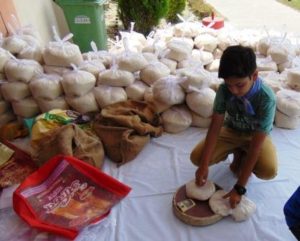
This outreach is made possible through the contributions in cash and kind from various institutions such as St Xavier’s Colleges in Digha, Carmel School and Patna Women’s College, St. Joseph’s School, Bankipore and a few other schools and individuals C/O Fr. Peter Arockiasamy, SJ (Development Office) have also contributed in cash and kind. There has been an overwhelming response from the staff and students of KREA, Bettiah, West Champaran and from other Catholic institutions .
After an announcement was made by the respective principals in KR campus, students and staff brought items such as rice, dal, match boxes, etc. Some of the smaller kids brought new uniforms that were kept for their use. The students and staff packed various items as per plan and a few representatives took the packets all the way to Ratanpurwa and Gaunaha and were part of distribution. READ and KR together procured the required items including tarpaulins and transported them to the centres for distribution. Children of Ratanpurwa and Gaunaha campuses are also actively involved in collection and distribution.
—-
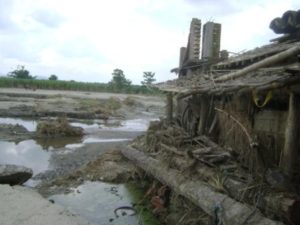
The Ratanpurwa and Gaunaha team along with the staff initially identified about 20 villages needing immediate attention. Now with roads becoming more usable and communications being restored, they have identified another 10 flood hit villages.
Of the 30 villages, 20 were categorized as the most affected and a target of reaching out to 1000 families in Ramnagar and Gaunaha blocks has been set. A village level assessment was done in a rapid manner and a door to door survey format was developed. Information is being gathered for improved interventions. While the general village assessment is ready, the door to door survey is to being done 10 to 15 Sept., 2017.


